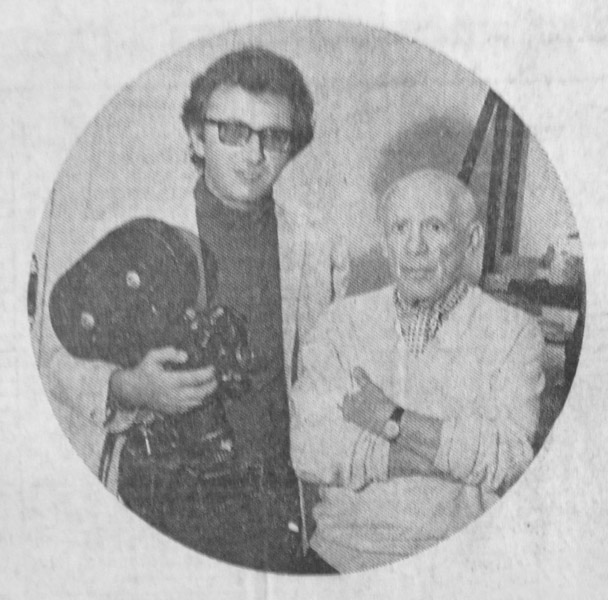Friendship as a ferment of a donation
Jean-Maurice Rouquette was appointed Director of the Musée de la Ville on October 1, 1956. He was a friend of Lucien Clergue, who "captured reality in an entirely astounding way," and the two men had shared their thoughts two years earlier about the celebration of the city's 2000th anniversary. The year 1954 marked the beginning of a deep connection with each other and between their respective careers. In 1956, Jean-Maurice Rouquette was formally appointed curator. He began his quest to revitalize a run-down fine arts museum, aiming to create a photography department that would eventually see the light in 1965. Lucien Clergue, a young photographer, met Picasso in 1953. The painter appreciated Clergue's work, the singularity of his photographs, and the enthusiasm and spontaneity of this young man, who proceeded to take numerous pictures of the artist, particularly when he attended the bullfights at the Arles bullring. Picasso loved going to the bullfights, gathering people around him, attending the show. No less than forty-two bullfight tickets from Nîmes and Arles were found in his archives after his death, bearing witness to the intimate Picasso, who kept everything and transformed "whatever happens to fall into my hands" as he mentioned to his personal secretary Jaime Sabartés, according to the latter's account in his book Picasso, Portraits and Souvenirs.
Rouquette dreamed of holding a Picasso exhibition. One afternoon at the bullfights, a nervous Lucien Clergue summoned the courage to approach Picasso, and the two agreed to meet again. An ongoing friendship was born at that encounter, and the two young friends went to visit the artist, who introduced them to Douglas Cooper. Cooper helped them hone down their project. That was how Jean-Maurice Rouquette was able to get works on loan from several collectors. Douglas Cooper had become a close friend of Picasso's after the Second World War. According to Pierre Daix, who describes Cooper in his Dictionnaire Picasso, " given his taste for collecting and his sound knowledge of art history, over the years Cooper became one of leading collectors of Picasso's work, which he kept at his Castille castle in the Gard department." Picasso enjoyed visiting Cooper when he went to the bullfights in Nîmes. Their relationship was punctuated by fondness and arguments that led to their losing contact towards the end of the painter's life.
After seeing the list of works to be shown, Picasso decided to loan some drawings from his own collection as well: thirty-eight altogether, none of which had yet been shown, the earliest dating back to 1898. The exhibition had an exceptional impact during the summer of 1957. illustration affiche-expo-1957Picasso went to visit it. For the occasion, the mayor gave him the costume of a cattle herdsman from the Camargue: he knew how much the artist enjoyed disguises, makeup, wearing outlandish hats, having fun and posing to make people laugh. Picasso was in heaven.
After that, Jean-Maurice Rouquette undertook a major renovation of the museum. Picasso went to the bullfights in Arles and met his friends for lunch at the Place du Forum, where he often ran into exiled Spaniards who had fled the Franco regime. Picasso gave them engravings, which he signed so that they could sell them and live off the earnings. The artist invited friends of friends and always dined in the company of all these people. This custom developed over the years, and Picasso never lacked festive gatherings in the town of Arles, an opportunity for him to join the crowd and get back in touch with his friends and his roots.
Although Jean-Maurice Rouquette organized other Picasso exhibitions, he always had the idea of holding a unique, unforgettable retrospective for the artist's ninetieth birthday. "All we are waiting for is you," he repeated when they met. The curator envisaged either an exhibition of the works that Picasso produced in Arles–although they were dispersed in many different collections–or a series, chosen in agreement with the artist and borrowing from Louise Leiris part of the body of work that she was preparing for the spring 1971 exhibition. He opened up to the dealer, asking for her opinion, in a letter dated April 6, 1971 and held in the museum's archives: "I called Picasso on the phone a few days ago, and he answered most kindly, but I dare not bother him too often when he is working. [...] Therefore, I am taking the liberty of appealing once again to your untiring kindness by asking you to advise me about the choice of one of the two possible solutions and about the way of presenting them to Picasso. If you were to have the opportunity to see him before we do, it would be ever so kind of you to put in a word concerning our projects."





 Summary
Summary